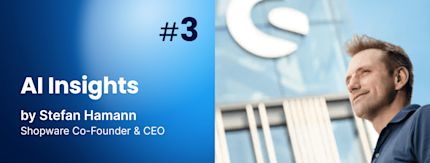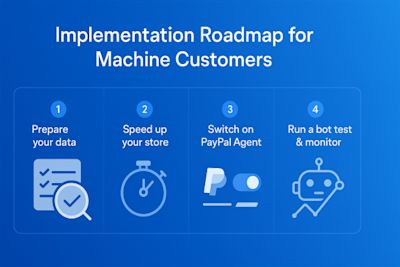
Signals are pouring in from every corner of our merchant community. One founder shows me a dashboard where orders from agent driven buyers have doubled week on week for four straight weeks. Another calls in from his roastery and says, “Stefan, I have sold coffee online for fifteen years and I have never seen a new channel explode like this. It converts better than anything on my site, and I did absolutely nothing to coax it.”
Those voices captured the moment better than any chart ever could. They confirm what our product telemetry has hinted at for months: autonomous agents are not a distant trend, they are already queuing up at the checkout. That is why I wrote “When Customers Turn Into Code”. It is a field guide forged from real numbers and grounded conversations, built to help every Shopware merchant ride the fastest growing channel commerce has met in decades.
A morning without pixels
- At 07 : 03 an order lands in the ERP. - Customer name: 0x17F3-PayPalBot. - Cart: two pallets of espresso beans, one industrial grinder, overnight shipping.
No cookie banners, no “add to cart”, no seven-touch nurture funnel. A reasoning loop inside an agent decided spec it, price, availability, and risk – all before a single human sipped the first latte.
In my “AI is eating ecommerce for breakfast – Agentic Commerce just took the first bite” article I argued that the classic funnel has collapsed to the length of a coffee blink . A week later “Good-bye click path, hello thought chain” mapped the same compression in detail and coined the half-second economy . Today we flip the camera: what happens when the buyer is also code, and how can merchants turn that shock into tail-wind?
1. The rise of the machine customer
Gartner estimates that by 2030 up to half of all replenishment purchases will be delegated to autonomous agents. My inbox suggests the wave is arriving earlier. Bots chew through structured feeds and logistics APIs, weigh options, then swipe Visa Intelligent Commerce without ever blinking – literally.
For the merchant this means three instant shifts:
• Discovery moves to data quality – If your JSON feed is sparse, you are invisible.
• Differentiation moves to objective uniqueness – Proprietary specs, exclusive content, service SLAs.
• Loyalty moves to latency – The agent rewards whoever answers fastest with accurate stock and price.

The "Machine Customer" rises fast
2. Anatomy of a machine buyer
Setting the stage
Imagine Monday morning in Münster. The espresso still gurgles in the portafilter when a merchant messages me, “Stefan, the new bot traffic just passed my human checkout before breakfast. Conversion looks like a cheat code.” I laugh, spill a little coffee, and open his dashboard. The graph resembles a ski jump in reverse. Up only.
That is when the penny drops: machine customers already shop faster than we can brew a double shot. They have zero patience for missing data and even less for lag. They pay with tokenized wallets and they keep receipts that would make any auditor proud.
Below is the distilled anatomy of these silicon shoppers, sorted by what matters first. Crack the top two layers today and you are in the short list when PayPalBot rolls in tomorrow.
Priortiy | Layer | Merchant Action |
|---|---|---|
1 | Preference and policy graph | Enrich every SKU feed with structured data |
2 | Decision time SLA | 100 ms of latency translates to revenue loss |
3 | PayPal Agent credential | Accept PayPal token-ready payments |
4 | Audit trail and trace ID | Compliance requires sealed logs of AI-initiated orders |
3. Four KPIs every board should track
Back in “When Code Writes Code” I shared how AI first engineering melted my backlog and shifted oversight from syntax to strategy . The same mindset applies to commerce data. Replace vanity page views with numbers that matter to bots:
Priority | KPI | Why it matters |
|---|---|---|
Track today | Data fill rate | Bots skip items with incomplete data |
Track today | Update speed | Outdated stock or price makes bots backlist |
Watch next | Uniqueness | Exclusive data boosts ranking |
Watch next | Bot trust rcating | Missed SLAs shift spend elsewhere |
Feed Completeness – ratio of non–null attributes to total required attributes.
Feed freshness – average age of stock and price data in seconds.
Uniqueness score – share of attributes that are unique to your catalogue versus the category baseline.
Trust score – percentage of orders meeting published SLAs.
Bonus: wire these metrics into your operational dashboard and watch how human teams start competing with the bots for precision.
4. Implementation blueprint

Step 1 – Prepare your data
Think spring-cleaning for product info. Check every item in Shopware: title, specs, price, stock level, warranty. Fill the blanks, delete the dust bunnies. The richer the data, the easier a bot can pick you.
Step 2 – Speed up your store
Bots quit if they wait. Aim for sub-second responses on product, stock and price. If the dial is red, enable the built-in cache or move heavy images to a CDN.
Step 3 – Switch on PayPal Agent (as soon as available)
PayPal’s new token lets an agent pay without showing a card. As soon as we update the PayPal plugin, tick “Enable Agent Checkout” and run the wizard. Now machine customers can pay as fast as they think.
Step 4 – Run a bot test and monitor
Make sure that you play and test with what data you exposing and where you can optimize.
That is it. Four boxes to tick, no PhD required. Once you complete them, you are open for business in the half-second economy. Coffee break optional. ☕
5. Turning bot traffic into real-world margin
Picture your store as a busy espresso bar. Human shoppers linger, browse and chat. Machine customers behave more like riders on e-bikes: they glide in, know exactly what they want and zip away in seconds. They are speed, not spectacle. Your job is to hand them a perfect cup before they even slow down. Do that and the extra revenue lands in your till while the rest of the street is still steaming milk.
Revenue lever | What does it mean in everyday trade | How to switch it on in Shopware |
|---|---|---|
Smart reorder | The bot watches stock in the customer's pantry or warehouse and places the refill order the moment levels run low | Add a ''minimum stock'' field to your products, publish it in the feed, and enable the Reorder webhook in the admin. Shopware handels the rest |
Bot built bundles | Agents love ready-made kits. Offer products as a package that score better value. | Use the Dynamic Product Group feature to create kits and expose the bundle ID in your feed |
B2B agent quotes | Corporate buyers run procurement bots that fetch three quotes before lunch. | Turn on the B2B Suite, publish your /agent/quote endpoint and map your price tiers. You are now in every robot's tender list |
Make sure, you fully adapt to the new mechanics of making money in commerce
Re-ordering agents – Auto replenish consumables when inventory dips below threshold.
Dynamic bundles – Let bots assemble compatible kits, then surface a one-click approval to the human owner.
B2B procurement – Embed Shopware into ERP marketplaces so corporate buyers can call /agent/quote directly.
Execution Engine Optimization outperforms SEO in this world, a point I stressed in the thought-chain article. Invest in the pipes, not the pixels.
6. Shopware’s angle
We built Shopware on the principle of Open Commerce. Machine to machine trade is the ultimate validation of that vision and we will optimize our "Agentic Commerce" readiness in fast iterations, including:
Agent ready feeds – Auto-generated OpenAI discovery files.
Latency-first cart – In-memory pricing and stock service measured in micro-seconds.
Policy engine – Declarative guardrails that sign every response with an HMAC, giving agents cryptographic proof.
All features ship under an MIT-licence. Because the future should be open, even when your customer is a line of code.
7. Call to action
Spin up a sandbox wallet this week and point a test agent at your feed. If the bot converts without a single human pixel, pour yourself another espresso – you just entered the half-second economy. If it fails, you have a backlog grooming session ahead. Either outcome beats waiting.
Stay curious, keep shipping, and remember: the next big buyer persona may not have a persona at all but only an API key. 🚀

You might also be interested in:










